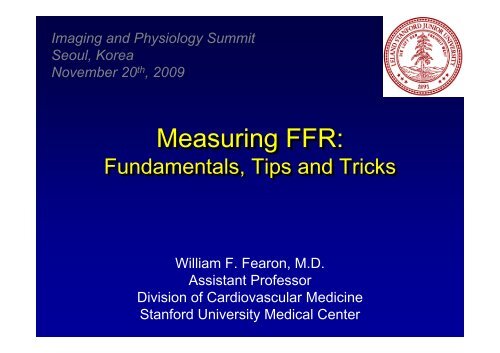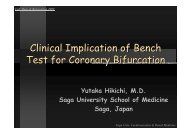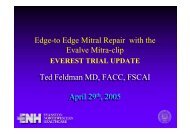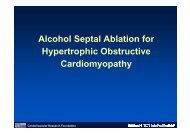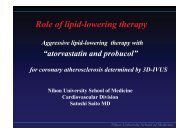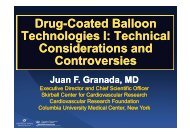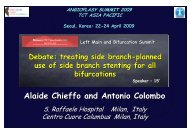Measuring FFR: Measuring FFR: - summitMD.com
Measuring FFR: Measuring FFR: - summitMD.com
Measuring FFR: Measuring FFR: - summitMD.com
Create successful ePaper yourself
Turn your PDF publications into a flip-book with our unique Google optimized e-Paper software.
Imaging and Physiology Summit<br />
Seoul, Korea<br />
November 20 th , 2009<br />
<strong>Measuring</strong> <strong>FFR</strong>:<br />
Fundamentals, Tips and Tricks<br />
William F. Fearon, M.D.<br />
Assistant Professor<br />
Division of Cardiovascular Medicine<br />
Stanford University Medical Center
Derivation of <strong>FFR</strong><br />
• <strong>FFR</strong> =<br />
• Flow =<br />
Myocardial Flow (Stenosis)<br />
Myocardial Flow (Normal)<br />
Pressure<br />
Resistance<br />
• at maximal hyperemia<br />
Flow ≈ Pressure<br />
Stanford
Derivation of <strong>FFR</strong><br />
• <strong>FFR</strong> =<br />
• Flow =<br />
Coronary Pressure (Stenosis)<br />
Coronary Pressure (Normal)<br />
Pressure<br />
Resistance<br />
• at maximal hyperemia<br />
Flow ≈ Pressure<br />
Stanford
Fractional Flow Reserve<br />
Proximal<br />
Pressure<br />
Distal<br />
Pressure<br />
<strong>FFR</strong> = P d / P a<br />
during maximal flow<br />
P a<br />
P d<br />
Stanford
• Clearly defined normal value<br />
• Not affected by resting hemodynamics<br />
• Relatively easy to perform<br />
Adapted from: Pijls and De Bruyne, Coronary Pressure<br />
Kluwer Academic Publishers, 2000<br />
Stanford
<strong>FFR</strong> in Intermediate Lesions<br />
Fractional Flow Reserve<br />
Exercise<br />
Test<br />
Thallium<br />
Scan<br />
Stress<br />
Echo<br />
0.75<br />
<strong>FFR</strong> < 0.75 : Sensitivity = 88%<br />
Specificity = 100%<br />
Pijls et al., New Engl J Med 1996;334:1703<br />
Stanford
<strong>FFR</strong> and the “Grey Zone”<br />
De Bruyne, et al. Circulation 2001;104:157-62<br />
Stanford
<strong>FFR</strong> and the “Grey Zone”<br />
Sensitivity<br />
Specificity<br />
<strong>FFR</strong>=0.75 0.80<br />
De Bruyne, et al. Circulation 2001;104:157-62<br />
Stanford
“Grey Zone”<br />
Stanford
Cardiac Death and MI After 5 Years<br />
20 %<br />
15<br />
10<br />
P=0.20<br />
P< 0.003<br />
7.9<br />
P< 0.005<br />
15.7<br />
5<br />
3.3<br />
0<br />
DEFER PERFORM REFERENCE<br />
<strong>FFR</strong> ≥ 0.75 <strong>FFR</strong> < 0.75<br />
Pijls et al. J Am Coll Cardiol 2007;49:2105-11<br />
Stanford
Danger of Deferring PCI if <strong>FFR</strong> < 0.75<br />
97 patients with intermediate lesions and normal nuclear scans<br />
% M.A.C.E. at 1 Year<br />
40<br />
35<br />
30<br />
25<br />
20<br />
15<br />
10<br />
5<br />
0<br />
27%<br />
(N=15)<br />
P
<strong>FFR</strong>-Guided PCI vs. Angio-Guided PCI<br />
in Multivessel CAD<br />
Results of the<br />
FAME study:<br />
Absolute Difference in MACE-Free Survival<br />
1. Improved out<strong>com</strong>es<br />
2. Decreased cost<br />
3. Less contrast use<br />
4. Similar procedure time<br />
<strong>FFR</strong>-guided PCI<br />
Angio<br />
<strong>FFR</strong><br />
$6,007 vs $5,332, p
Pitfalls / Tips & Tricks<br />
• Inadequate hyperemia<br />
• Pressure drift<br />
• Guide catheter / wire issues<br />
• Particular patient subsets<br />
• Incorporating physiology into your practice<br />
Stanford
Potential Pitfalls<br />
• Inadequate hyperemia<br />
– Intracoronary adenosine<br />
• Short-lasting peak effect (∼5 seconds)<br />
• Don’t use a guiding catheter with sideholes<br />
• If one suspects inadequate hyperemia, then<br />
increase dose (>100 micrograms) or use<br />
intravenous adenosine<br />
Stanford
Potential Pitfalls<br />
• Inadequate hyperemia<br />
– Intravenous adenosine<br />
• Should be administered via central vein<br />
• May require higher doses (>140 ug/kg/min) if given<br />
peripherally to avoid metabolism<br />
Stanford
Performing <strong>FFR</strong><br />
Pressure Pullback<br />
Focal LAD Lesion<br />
Proximal Edge of<br />
LAD lesion<br />
Distal LAD<br />
Stanford
Performing <strong>FFR</strong><br />
Pullback in Moderately and<br />
Diffusely Diseased LAD<br />
Distal<br />
Proximal<br />
Stanford
Potential Pitfalls<br />
• Inadequate hyperemia<br />
– Intracoronary Papaverine<br />
• Peak lasts 30-60 seconds, allowing pullback<br />
• Transient QT prolongation, T wave changes<br />
• Rarely causes VT / Torsade de Pointes<br />
Stanford
Papaverine-Induced Arrhythmia<br />
Papaverine bolus<br />
Stanford
Potential Pitfalls<br />
• Inadequate hyperemia<br />
–Caffeine<br />
• Competitive inhibitor of the adenosine A2a<br />
receptor<br />
• Small studies have shown that caffeine may<br />
decrease the sensitivity of dipyridamole stress<br />
tests<br />
• Dipyridamole indirectly increases endogenous<br />
adenosine by blocking the cellular reuptake<br />
mechanism<br />
Stanford
Caffeine and <strong>FFR</strong><br />
<strong>FFR</strong> measured with 30-50 ugs of IC adenosine<br />
before and after 2-3 “cups” of coffee<br />
Aqel, et al. Am J Cardiol 2004;93:343-346.<br />
Stanford
Pitfalls / Tips & Tricks<br />
• Inadequate hyperemia<br />
• Pressure drift<br />
• Guide catheter / wire issues<br />
• Particular patient subsets<br />
• Incorporating physiology into your practice<br />
Stanford
Potential Pitfalls<br />
Recognizing True Pressure Drift<br />
Pijls et al. Cathet Cardiovasc Intervent 2000;49:1-16<br />
Stanford
Potential Pitfalls<br />
• Pressure Drift<br />
– Causes of artifactual drift<br />
• Wire introducer<br />
• Paradoxical gradient<br />
• Contrast in guide catheter<br />
Stanford
Pitfalls / Tips & Tricks<br />
• Inadequate hyperemia<br />
• Pressure drift<br />
• Guide catheter / wire issues<br />
• Particular patient subsets<br />
• Incorporating physiology into your practice<br />
Stanford
Cranial View of the LAD<br />
Stanford
<strong>FFR</strong> of the LAD…<br />
Is this correct?<br />
Stanford
Deep-Seated Guide Resulting<br />
in Ventricularization<br />
Stanford
Unseating of Guide Catheter<br />
Reveals True <strong>FFR</strong><br />
Stanford
De Bruyne et al. Cathet Cardiovasc Diagn 1994;33:145-152.<br />
Stanford
Wiring Tortuous Vessels<br />
Distal end of wire<br />
Consider disconnecting the wire<br />
from the interface connector<br />
Can use exchange catheter to more<br />
safely position the pressure wire<br />
Interface connector<br />
Stanford
Pitfalls / Tips & Tricks<br />
• Inadequate hyperemia<br />
• Pressure drift<br />
• Guide catheter / wire issues<br />
• Particular patient subsets<br />
• Incorporating physiology into your practice<br />
Stanford
Potential Pitfalls<br />
• Particular patient subsets<br />
–LVH<br />
• ↑↑ muscle mass <strong>com</strong>pared to vasculature<br />
• <strong>FFR</strong> cuttoff value may be higher than 0.75<br />
– Exercise-induced vasoconstriction<br />
• Greater stenosis with exercise <strong>com</strong>pared to<br />
adenosine<br />
Stanford
<strong>FFR</strong> during STEMI<br />
Stanford
<strong>FFR</strong> during STEMI<br />
Stanford
<strong>FFR</strong> during STEMI<br />
IMR = Pressure / Flow = 78 / (1/1.22) = 95<br />
Stanford
Acute Microvascular Damage and <strong>FFR</strong><br />
STEMI<br />
Variable Degree of<br />
Reversible Microvascular<br />
Stunning<br />
Maximum Achievable<br />
Flow is Less<br />
With time, the microvasculature may<br />
recover, maximum achievable flow<br />
may increase, and a larger gradient<br />
with a lower <strong>FFR</strong> may be measured<br />
across a given stenosis<br />
Smaller Gradient and<br />
Higher <strong>FFR</strong> across<br />
Any Given Stenosis<br />
Stanford
<strong>FFR</strong> in Chronic MI<br />
<strong>FFR</strong> in Chronic MI<br />
67 yo man 9 months after STEMI and PCI of Cx<br />
Stanford
<strong>FFR</strong> in Chronic MI<br />
<strong>FFR</strong> of Left Circumflex<br />
Resting<br />
IV Adenosine<br />
Stanford
Chronic Microvascular Damage and <strong>FFR</strong><br />
Old Myocardial<br />
Infarction<br />
Irreversible Microvascular<br />
Damage<br />
In the setting of chronic microvascular<br />
dysfunction, the higher <strong>FFR</strong> is not<br />
falsely elevated, but reflects the<br />
smaller amount of viable myocardium<br />
supplied by the vessel and still<br />
provides information about the<br />
expected gain in flow after PCI<br />
Maximum Achievable<br />
Flow is Less<br />
Smaller Gradient and<br />
Higher <strong>FFR</strong> across<br />
Any Given Stenosis<br />
Stanford
<strong>FFR</strong> in Chronic MI<br />
Comparison of <strong>FFR</strong> in 57 patients with an MI ≥ 6<br />
days old to SPECT imaging before and after PCI<br />
De Bruyne et al. Circulation 2001;104:157-162<br />
Stanford
<strong>FFR</strong> in NSTE ACS<br />
Comparison of MACE in FAME patients with and without ACS<br />
Stanford
Incorporating Physiology<br />
Stanford
Incorporating Physiology<br />
• Educating your assistants<br />
– Limitations of angiography<br />
– Benefits of physiology<br />
– Measure <strong>FFR</strong> in 10 consecutive PCI cases<br />
• Streamlining set-up<br />
– Identify point person<br />
– Post medication mixing and dosing instructions<br />
– Keep analyzer connected at all times<br />
Stanford


